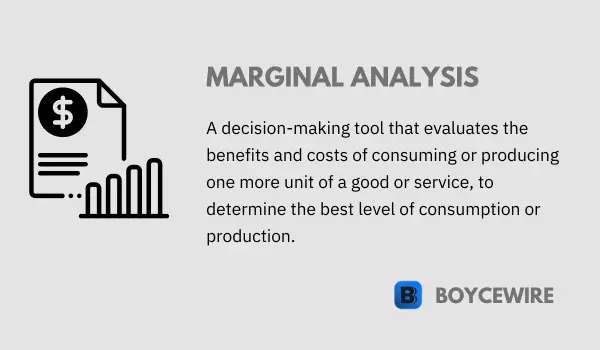Table of Contents ![]()
Marginal Analysis: Definition, Sectors & Examples

What is Marginal Analysis?
Marginal analysis is a fundamental concept in economics that involves evaluating the additional benefits and costs of a decision. It helps individuals, firms, and governments make optimal choices by considering the incremental effects of their actions.
By focusing on the marginal changes, decision-makers can ensure they allocate resources efficiently, maximize profits, or achieve the desired social outcomes. This article will provide an overview of key concepts in marginal analysis, discuss practical examples, explain the relevant formulas, and illustrate the use of graphs in understanding these concepts.
In the following sections, we will explore the importance of marginal analysis in various decision-making contexts, such as consumer choices, producer decisions, government policy, and environmental management. By understanding the principles of marginal analysis, individuals and organizations can make more informed decisions that lead to better outcomes for themselves and society as a whole.
Key Points
- Marginal analysis is the examination of the benefits and costs of consuming or producing one additional unit of a good or service.
- The purpose of marginal analysis is to determine the optimal level of consumption or production of a good or service based on the additional benefits gained from each additional unit consumed or produced.
- Marginal benefit refers to the additional benefit gained from consuming or producing one additional unit of a good or service, while marginal cost refers to the additional cost incurred from consuming or producing one additional unit.
- Decision-makers can use marginal analysis by comparing the marginal benefit to the marginal cost of consuming or producing one additional unit to determine whether it is worthwhile to consume or produce more of that good or service.
Marginal Analysis Concepts
Marginal analysis relies on a few key concepts that are essential for understanding its applications in economics and decision-making. These concepts are marginal cost, marginal benefit, and marginal utility.
Marginal cost refers to the additional cost incurred when producing or consuming one more unit of a good or service. In other words, it is the cost of making one more incremental change. For firms, it represents the cost of producing an additional item, while for consumers, it could represent the cost of purchasing or using one more unit of a good or service.
Marginal benefit is the additional benefit or satisfaction gained from consuming or producing one more unit of a good or service. It helps individuals and firms understand the trade-offs involved in their decisions. For example, a consumer may experience increased satisfaction from consuming one more slice of pizza, while a firm may gain additional revenue from producing and selling an extra product.
Marginal utility is a concept that measures the additional satisfaction or happiness a consumer derives from consuming one more unit of a good or service. It is closely related to the concept of marginal benefit. As a consumer consumes more units of a particular good or service, the marginal utility typically decreases, reflecting the law of diminishing marginal utility. This law states that as a person consumes more of a good or service, the additional satisfaction they gain from each additional unit decreases.
Marginal Cost
Marginal Benefit
Marginal Utility
Understanding these basic concepts is crucial for applying marginal analysis in various decision-making contexts. By comparing marginal costs and benefits, individuals, firms, and governments can make optimal choices that maximize their overall welfare.
Marginal Analysis Examples
Marginal analysis is widely applied in different areas of economics and decision-making. Here, we will discuss some practical examples that illustrate the use of marginal analysis in various contexts.
1. Consumer Decision-Making
When deciding how much of a good or service to purchase, consumers weigh the marginal benefits and costs. For example, a consumer may consider the satisfaction derived from eating an extra slice of pizza versus the cost of purchasing it. If the marginal benefit (satisfaction) is greater than the marginal cost (price), the consumer will choose to buy and consume the extra slice.
2. Business Production Decisions
Firms use marginal analysis to determine the optimal level of production for their goods and services. By comparing the marginal cost of producing one more unit with the marginal revenue generated from selling it, firms can maximize their profits. If the marginal revenue is greater than the marginal cost, the firm should increase production. Conversely, if the marginal cost is greater than the marginal revenue, the firm should decrease production.
3. Government Policy
Governments use marginal analysis to evaluate the efficiency of public policies and allocate resources accordingly. For example, when deciding on healthcare spending, a government may compare the marginal benefits of investing in different healthcare programs with their respective costs. By allocating resources to programs with the highest marginal benefits per dollar spent, the government can ensure the efficient use of public funds.
4. Environmental Management
Marginal analysis can also be applied to environmental issues, such as pollution control. Regulators may weigh the marginal benefits of reducing pollution, such as improved public health and environmental quality, against the marginal costs of implementing pollution control measures. By finding the optimal level of pollution reduction, regulators can minimize the overall economic and social costs while maximizing the benefits.
These examples demonstrate the broad applicability of marginal analysis in various decision-making contexts. By comparing marginal costs and benefits, individuals, firms, and governments can make more informed decisions that lead to better outcomes.
Marginal Analysis Formula
In the context of marginal analysis, formulas are used to calculate marginal costs and benefits. These formulas help us understand how each additional unit impacts overall costs or benefits, ultimately guiding decision-making. Here are some common formulas used in marginal analysis:
Marginal Benefit (MB) Formula
Marginal Benefit = (Change in Total Benefit) / (Change in Quantity)
This formula calculates the additional benefit derived from consuming or producing one more unit of a good or service. It is the difference in total benefits divided by the difference in the quantity of goods or services.
Marginal Cost (MC) Formula
Marginal Cost = (Change in Total Cost) / (Change in Quantity)
This formula calculates the additional cost incurred from producing or consuming one more unit of a good or service. It is the difference in total costs divided by the difference in the quantity of goods or services.
Marginal Revenue (MR) Formula
Marginal Revenue = (Change in Total Revenue) / (Change in Quantity)
This formula calculates the additional revenue generated from selling one more unit of a good or service. It is the difference in total revenues divided by the difference in the quantity of goods or services.
These formulas serve as the foundation for marginal analysis, allowing individuals, businesses, and governments to compare the incremental costs and benefits of different decisions. By evaluating these marginal costs and benefits, decision-makers can optimize their choices and maximize their overall outcomes.
Marginal Analysis Graph
Marginal analysis graphs visually represent the relationship between marginal costs, marginal benefits, and the quantity of goods or services. These graphs are particularly useful for understanding the optimal level of production or consumption in various scenarios. To create a marginal analysis graph, follow these steps:
- Plot the Quantity on the x-axis: The x-axis represents the quantity of goods or services produced or consumed.
- Plot Marginal Costs and Marginal Benefits on the y-axis: The y-axis represents the incremental costs and benefits associated with each additional unit of goods or services.
- Draw the Marginal Cost (MC) Curve: This curve illustrates the relationship between the quantity of goods or services and their associated marginal costs. Typically, as the quantity increases, marginal costs will also increase due to factors such as diminishing returns and increased resource scarcity.
- Draw the Marginal Benefit (MB) Curve: This curve illustrates the relationship between the quantity of goods or services and their associated marginal benefits. Often, as the quantity increases, marginal benefits will decrease as the utility derived from each additional unit diminishes.
- Identify the Equilibrium Point: The equilibrium point is where the MC and MB curves intersect. At this point, the additional cost of producing or consuming one more unit is equal to the additional benefit derived from that unit. This is the optimal quantity, as any further increase or decrease in production or consumption would result in a net loss of overall welfare.
By analyzing the marginal analysis graph, decision-makers can visually assess the optimal quantity of goods or services that should be produced or consumed. This allows them to make informed decisions that maximize utility, profits, or other objectives while minimizing costs and inefficiencies.
Limitations and Challenges in Marginal Analysis
While marginal analysis is a powerful tool for optimizing decision-making, it is not without its limitations and challenges. Some of these include:
- Simplifying Assumptions: Marginal analysis often relies on simplifying assumptions, such as linear relationships between variables or constant marginal costs and benefits. In reality, these relationships may be more complex and may not hold true across all situations, potentially limiting the accuracy of the analysis.
- Difficulties in Measurement: Accurately measuring marginal costs and benefits can be challenging, particularly when dealing with intangible or non-monetary factors. For example, quantifying the marginal benefits of improved environmental quality or the marginal costs of psychological stress can be difficult, leading to potential inaccuracies in the analysis.
- Short-term Focus: Marginal analysis often focuses on short-term decisions, which may not always align with long-term goals or considerations. For instance, a company may decide to cut costs in the short-term by reducing employee training or research and development, but these decisions could negatively impact the company’s long-term growth and competitiveness.
- Externalities: Marginal analysis may not always take into account externalities or indirect effects that result from a decision. For example, a business may optimize its production levels based on its own marginal costs and benefits, but may not consider the potential negative externalities, such as pollution or congestion, that its production may impose on society.
- Dynamic Contexts: In rapidly changing environments or situations with high levels of uncertainty, the marginal costs and benefits associated with a decision may change over time, making it difficult to apply marginal analysis effectively.
Conclusion
Marginal analysis is a crucial decision-making tool in economics, helping individuals and organizations to optimize their choices by considering the marginal costs and benefits associated with different alternatives. With its wide range of applications in various fields, marginal analysis can significantly improve decision-making processes and lead to more efficient allocation of resources.
However, it is essential to recognize the limitations and challenges of marginal analysis, such as simplifying assumptions, difficulties in measurement, short-term focus, externalities, and dynamic contexts. By understanding these limitations, decision-makers can make better use of marginal analysis and ensure that their decisions are more aligned with their long-term goals and broader societal impacts.
In conclusion, marginal analysis remains an indispensable tool for making informed decisions, but it should be used with caution and a comprehensive understanding of its limitations. By doing so, individuals and organizations can leverage the power of marginal analysis to make more effective choices and contribute to the overall efficiency and well-being of the economy.
FAQs
Marginal analysis is the examination of the benefits and costs of consuming or producing one additional unit of a good or service.
The purpose of marginal analysis is to determine the optimal level of consumption or production of a good or service based on the additional benefits gained from each additional unit consumed or produced.
Marginal benefit refers to the additional benefit gained from consuming or producing one additional unit of a good or service.
By comparing the marginal benefit of consuming or producing one additional unit of a good or service to the marginal cost of that unit, decision-makers can determine whether it is worthwhile to consume or produce more of that good or service.
About Paul
Paul Boyce is an economics editor with over 10 years experience in the industry. Currently working as a consultant within the financial services sector, Paul is the CEO and chief editor of BoyceWire. He has written publications for FEE, the Mises Institute, and many others.

Further Reading
 Law of Diminishing Marginal Returns: Definition & Examples - Diminishing Marginal Returns occur when increasing production further results in lower levels of output.
Law of Diminishing Marginal Returns: Definition & Examples - Diminishing Marginal Returns occur when increasing production further results in lower levels of output.  Externalities: Definition, Positive & Negative Examples - In economics, an externality refers to a cost or benefit that is imposed onto a third party.
Externalities: Definition, Positive & Negative Examples - In economics, an externality refers to a cost or benefit that is imposed onto a third party.  Anchoring Bias: Definition & Examples - Anchoring is a cognitive bias where a specific piece of information is relied upon to make a decision.
Anchoring Bias: Definition & Examples - Anchoring is a cognitive bias where a specific piece of information is relied upon to make a decision. 